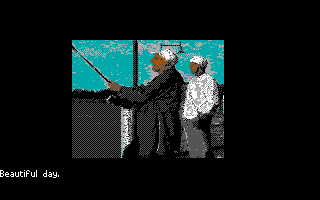Retro Replay Review
Gameplay
Mission: Impossible excels at blending strategy and action by placing you in charge of a four-man spy unit, each agent boasting unique skills and personal stats. You can split your team at will, sending one member to tap an enemy phone while another tails a suspect across town. This level of granular control turns every mission into a delicate juggling act, demanding careful timing and coordination.
(HEY YOU!! We hope you enjoy! We try not to run ads. So basically, this is a very expensive hobby running this site. Please consider joining us for updates, forums, and more. Network w/ us to make some cash or friends while retro gaming, and you can win some free retro games for posting. Okay, carry on 👍)
The real-time progression system adds a palpable sense of urgency to each objective. There’s no pausing the clock: you must issue orders on the fly, adapt to unexpected patrols, and occasionally improvise when your plans go awry. This dynamic pace keeps adrenaline levels high, but also rewards patience, foresight, and quick thinking when things go south.
The overhead map serves as both your battlefield and command center. You can zoom in for a closer look at enemy positions or zoom out to plan multi-agent maneuvers across sprawling urban environments. Markers, sightlines, and noise indicators help you anticipate enemy reactions, making stealthy infiltrations and daring heists feel immersive and authentic.
Light role-playing elements infuse each agent with personality and specializations—stealth, tech support, negotiation, or brute force. As you succeed in missions, agents earn experience that enhances speed, perception, or hacking prowess. These incremental improvements create an engaging little meta-game of character development, encouraging you to rotate team members and balance their strengths.
Graphics
The visual presentation in Mission: Impossible is functional yet atmospheric. The top-down perspective offers a clear, tactically oriented view of your surroundings, with detailed floor plans, furniture, and environmental cues. Although textures aren’t cutting-edge, the clarity and consistency of design ensure you always know where hiding spots, security cameras, and interactive objects lie.
Lighting and shadow play a crucial role in stealth gameplay, and the developers have paid special attention to how darkness conceals movement. Dimly lit corridors and vaulted ceilings create pockets of cover, while moving flashlights and guard cones of vision add dramatic tension. These effects are subtle but effective, heightening the sense that one wrong move could trigger alarms.
Character sprites and animations emphasize readability over realism. Agents have distinctive silhouettes and color trims so you can identify them at a glance during hectic exchanges. Enemy guard patrols loop on predictable paths, but their animated responses—raising weapons, signaling alarms, or backing off when they lose sight—add a touch of cinematic flair.
Performance is rock solid on a wide range of hardware, thanks to optimization of the game’s 2D assets and modest system requirements. Whether you’re playing on a high-end PC or older laptop, loading times remain short and frame rates stay stable. The minimalist UI complements the visuals by highlighting key information without cluttering the screen.
Story
Mission: Impossible doesn’t rely on a sprawling, Hollywood-style narrative; instead, it weaves a series of tightly focused espionage tales that test your team’s adaptability. Each mission briefing reads like a dossier—complete with intel on target identities, security infrastructure, and potential civilian hazards—giving you the freedom to plan your approach.
Behind the terse mission sheets lies a cast of operatives with distinct personalities and motivations. Casual banter between agents in transit adds levity, while radio chatter from HQ warns of looming threats. This interplay builds rapport and lends emotional weight when a mission goes sideways or a team member faces unexpected peril.
Antagonists are painted with broad strokes—terror cells, rogue scientists, and corrupt officials—yet the variety of objectives keeps the narrative fresh. One assignment might require a stealthy rescue operation in a snow-covered research facility, while the next forces you into a high-stakes hostage negotiation in a crowded marketplace.
Although there are no branching story arcs in the traditional sense, the game encourages multiple playthroughs by offering optional side objectives, hidden documents, and alternative infiltration routes. Discovering these secrets can unlock subtle narrative details about the enemy network and your agents’ past missions.
Overall Experience
Mission: Impossible stands out as a cerebral take on the spy genre, offering enough tactical depth to satisfy strategy fans while maintaining the thrill of clandestine operations. The combination of real-time decision-making and light RPG progression keeps each mission engaging from start to finish.
Beginners may find the interface slightly intimidating at first, especially when juggling multiple agents in heated encounters. However, the gentle learning curve and in-game tutorials quickly demystify core mechanics, transforming initial frustration into mastery of covert techniques.
Replayability is a major strength: the same map can yield wildly different experiences depending on your approach, agent load-outs, and the order in which you tackle objectives. This sandbox structure encourages experimentation and rewards creativity, whether you prefer a ghost-like infiltration or an all-out diversion.
For players seeking a thoughtful, strategy-driven espionage adventure, Mission: Impossible delivers a rich, nuanced experience. Its polished real-time controls, atmospheric presentation, and character-driven missions combine into a cohesive intelligence thriller that will keep you coming back for “one more” covert operation.
 Retro Replay Retro Replay gaming reviews, news, emulation, geek stuff and more!
Retro Replay Retro Replay gaming reviews, news, emulation, geek stuff and more!









Reviews
There are no reviews yet.